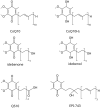The Optic Nerve at Stake: Update on Environmental Factors Modulating Expression of Leber's Hereditary Optic Neuropathy
- PMID: 38540197
- PMCID: PMC10968140
- DOI: 10.3390/biomedicines12030584
The Optic Nerve at Stake: Update on Environmental Factors Modulating Expression of Leber's Hereditary Optic Neuropathy
Abstract
Optic neuropathies are characterized by the degeneration of the optic nerves and represent a considerable individual and societal burden. Notably, Leber's hereditary optic neuropathy (LHON) is a devastating vision disease caused by mitochondrial gene mutations that hinder oxidative phosphorylation and increase oxidative stress, leading to the loss of retinal ganglion neurons and axons. Loss of vision is rapid and severe, predominantly in young adults. Penetrance is incomplete, and the time of onset is unpredictable. Recent findings revealed that the incidence of genetic LHON susceptibility is around 1 in 1000, much higher than believed till now. Environmental factors are critical in LHON triggering or severity. Families at risk have a very strong demand for how to prevent the onset or limit the severity of the disease. Here, we review recent knowledge of the extrinsic determinants of LHON expression, including lifestyle, dietary supplements, common chemicals, and drugs.
Keywords: Leber’s hereditary optic neuropathy; drugs; environmental factors; mitochondrial disease; neurodegeneration; optic neuropathy.
Conflict of interest statement
The authors declare no conflicts of interest.
Figures






Similar articles
-
Leber's Hereditary Optic Neuropathy as a Promising Disease for Gene Therapy Development.Adv Ther. 2019 Dec;36(12):3299-3307. doi: 10.1007/s12325-019-01113-2. Epub 2019 Oct 11. Adv Ther. 2019. PMID: 31605306 Free PMC article.
-
Leber's Hereditary Optic Neuropathy: The Mitochondrial Connection Revisited.Middle East Afr J Ophthalmol. 2011 Jan;18(1):17-23. doi: 10.4103/0974-9233.75880. Middle East Afr J Ophthalmol. 2011. PMID: 21572729 Free PMC article.
-
The metabolomic signature of Leber's hereditary optic neuropathy reveals endoplasmic reticulum stress.Brain. 2016 Nov 1;139(11):2864-2876. doi: 10.1093/brain/aww222. Brain. 2016. PMID: 27633772
-
Optical Coherence Tomography of the Retinal Ganglion Cell Complex in Leber's Hereditary Optic Neuropathy and Dominant Optic Atrophy.Curr Eye Res. 2019 Jun;44(6):638-644. doi: 10.1080/02713683.2019.1567792. Epub 2019 Feb 4. Curr Eye Res. 2019. PMID: 30649972
-
Clinical spectrum of Leber's hereditary optic neuropathy.Clin Neurosci. 1997;4(5):295-301. Clin Neurosci. 1997. PMID: 9292259 Review.
Cited by
-
Technological advances in the diagnosis and management of inherited optic neuropathies.Front Neurol. 2025 Jul 25;16:1609033. doi: 10.3389/fneur.2025.1609033. eCollection 2025. Front Neurol. 2025. PMID: 40786632 Free PMC article. Review.
-
Optimised, Broad NGS Panel for Inherited Eye Diseases to Diagnose 1000 Patients in Poland.Biomedicines. 2024 Jun 18;12(6):1355. doi: 10.3390/biomedicines12061355. Biomedicines. 2024. PMID: 38927562 Free PMC article.
-
Leber Hereditary Optic Neuropathy: Support, Genetic Prediction and Accurate Genetic Counselling Enhance Family Planning Choices.Clin Exp Ophthalmol. 2025 Apr;53(3):292-301. doi: 10.1111/ceo.14493. Epub 2025 Feb 2. Clin Exp Ophthalmol. 2025. PMID: 39895156 Free PMC article. Review.
References
-
- Bourne R.R.A., Steinmetz J.D., Saylan M., Mersha A.M., Weldemariam A.H., Wondmeneh T.G., Sreeramareddy C.T., Pinheiro M., Yaseri M., Yu C., et al. Causes of Blindness and Vision Impairment in 2020 and Trends over 30 Years, and Prevalence of Avoidable Blindness in Relation to VISION 2020: The Right to Sight: An Analysis for the Global Burden of Disease Study. Lancet Glob. Health. 2021;9:e144. doi: 10.1016/S2214-109X(20)30489-7. - DOI - PMC - PubMed
Publication types
LinkOut - more resources
Full Text Sources

